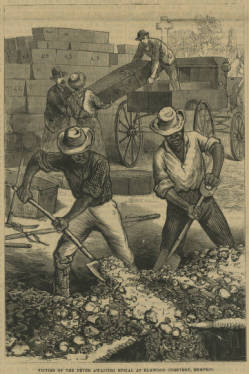Lower Mississippi Valley yellow fever epidemic of 1878
Epidemic of yellow fever in the United States
The Lower Mississippi Valley yellow fever epidemic of 1878 was one of the most severe outbreaks of yellow fever in the history of the United States. The epidemic primarily affected the Lower Mississippi Valley, including cities such as Memphis and New Orleans. It resulted in significant loss of life and had a profound impact on the region's economy and public health policies.
Background[edit | edit source]
Yellow fever is a viral disease transmitted by Aedes aegypti, a species of mosquito. The disease is characterized by fever, chills, loss of appetite, nausea, muscle pains, and headaches. In severe cases, it can lead to liver damage and bleeding, often resulting in death. The 19th century saw several outbreaks of yellow fever in the United States, particularly in the southern states where the climate was conducive to mosquito breeding.
The Epidemic[edit | edit source]
The 1878 epidemic began in the summer and quickly spread through the Lower Mississippi Valley. The first cases were reported in New Orleans, a major port city with a history of yellow fever outbreaks. From there, the disease spread northward along the Mississippi River, affecting towns and cities in Louisiana, Mississippi, Arkansas, and Tennessee.
Impact on Memphis[edit | edit source]
Memphis was one of the hardest-hit cities during the epidemic. The city had a population of about 40,000 at the time, and it is estimated that over 5,000 people died from yellow fever. The epidemic caused widespread panic, and many residents fled the city. Those who remained faced quarantine measures and a breakdown of public services.
Public Health Response[edit | edit source]
The epidemic highlighted the need for improved public health measures. Quarantine stations were established, and efforts were made to control the mosquito population. However, the lack of understanding of the disease's transmission hindered effective response. The epidemic eventually subsided with the onset of cooler weather, which reduced mosquito activity.
Aftermath[edit | edit source]
The 1878 yellow fever epidemic had lasting effects on the affected regions. It prompted changes in public health policies, including the establishment of health boards and the implementation of sanitation measures. The epidemic also spurred scientific research into the causes and transmission of yellow fever, eventually leading to the discovery of the mosquito vector.
Legacy[edit | edit source]
The epidemic is remembered as a significant event in the history of public health in the United States. It underscored the importance of disease prevention and control, and it paved the way for future advancements in medical science and public health infrastructure.
Related pages[edit | edit source]
Search WikiMD
Ad.Tired of being Overweight? Try W8MD's physician weight loss program.
Semaglutide (Ozempic / Wegovy and Tirzepatide (Mounjaro / Zepbound) available.
Advertise on WikiMD
|
WikiMD's Wellness Encyclopedia |
| Let Food Be Thy Medicine Medicine Thy Food - Hippocrates |
Translate this page: - East Asian
中文,
日本,
한국어,
South Asian
हिन्दी,
தமிழ்,
తెలుగు,
Urdu,
ಕನ್ನಡ,
Southeast Asian
Indonesian,
Vietnamese,
Thai,
မြန်မာဘာသာ,
বাংলা
European
español,
Deutsch,
français,
Greek,
português do Brasil,
polski,
română,
русский,
Nederlands,
norsk,
svenska,
suomi,
Italian
Middle Eastern & African
عربى,
Turkish,
Persian,
Hebrew,
Afrikaans,
isiZulu,
Kiswahili,
Other
Bulgarian,
Hungarian,
Czech,
Swedish,
മലയാളം,
मराठी,
ਪੰਜਾਬੀ,
ગુજરાતી,
Portuguese,
Ukrainian
Medical Disclaimer: WikiMD is not a substitute for professional medical advice. The information on WikiMD is provided as an information resource only, may be incorrect, outdated or misleading, and is not to be used or relied on for any diagnostic or treatment purposes. Please consult your health care provider before making any healthcare decisions or for guidance about a specific medical condition. WikiMD expressly disclaims responsibility, and shall have no liability, for any damages, loss, injury, or liability whatsoever suffered as a result of your reliance on the information contained in this site. By visiting this site you agree to the foregoing terms and conditions, which may from time to time be changed or supplemented by WikiMD. If you do not agree to the foregoing terms and conditions, you should not enter or use this site. See full disclaimer.
Credits:Most images are courtesy of Wikimedia commons, and templates, categories Wikipedia, licensed under CC BY SA or similar.
Contributors: Prab R. Tumpati, MD


